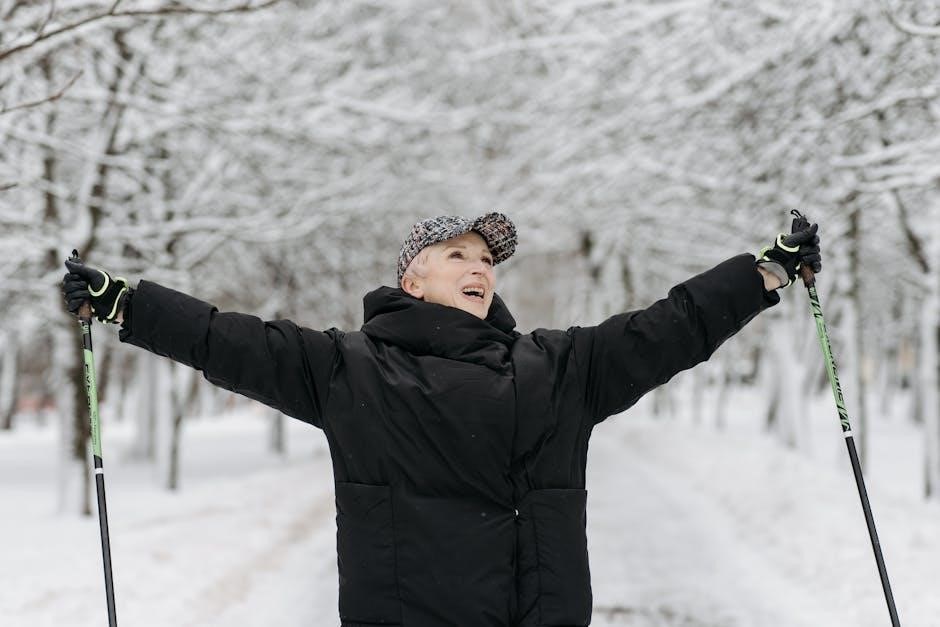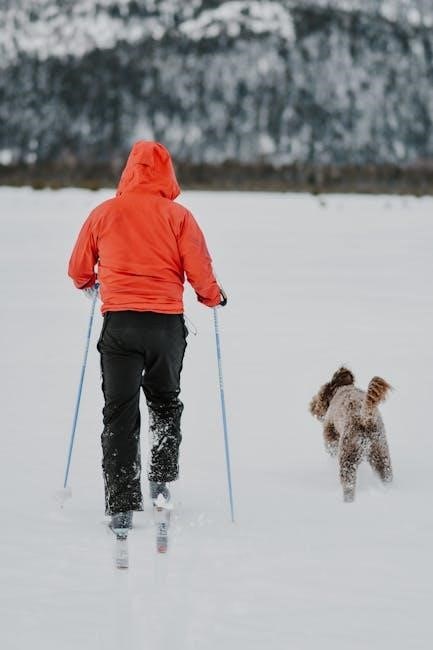Understanding the Importance of Proper Cross Country Ski Pole Sizing
Proper cross country ski pole sizing is crucial for optimizing performance‚ efficiency‚ and comfort. Correct length ensures effective technique‚ reduces fatigue‚ and enhances overall skiing experience.
Why Pole Length Matters for Performance and Comfort
Pole length significantly impacts cross-country skiing performance and comfort. Properly sized poles allow for efficient striding and propulsion‚ optimizing energy use. Too short‚ and your technique suffers‚ reducing glide and increasing fatigue. Too long‚ and your arms are overextended‚ straining shoulders and limiting control. Correct length ensures natural arm angles‚ promoting smooth‚ powerful strokes. It also enhances balance and stability‚ crucial for varying terrain. Comfort is directly tied to posture and alignment; poor fit leads to discomfort and fatigue. Thus‚ precise sizing is essential for maximizing efficiency‚ reducing strain‚ and maintaining proper skiing mechanics‚ ensuring a more enjoyable and effective experience on the trails.
Common Mistakes in Choosing the Wrong Pole Size
One of the most common mistakes is overestimating or underestimating height adjustments‚ leading to improper fit. Many skiers also fail to consider their skiing technique‚ assuming one size fits all. Ignoring terrain-specific needs is another error; longer poles may be needed for flat terrain‚ while shorter poles suit hilly or technical trails. Additionally‚ some skiers neglect to test poles before purchasing‚ which can result in poor comfort and performance. Finally‚ relying solely on manufacturer charts without personal adjustment is a frequent oversight. These mistakes can lead to discomfort‚ fatigue‚ and suboptimal skiing efficiency‚ emphasizing the importance of careful‚ personalized sizing.

Factors Influencing Cross Country Ski Pole Sizing
Ski pole sizing is influenced by skier height‚ body proportions‚ skiing technique‚ terrain type‚ and snow conditions‚ ensuring optimal performance and comfort during cross-country skiing.
Skier Height and Body Proportions
Skier height and body proportions are foundational in determining pole size. Taller skiers generally require longer poles‚ while shorter skiers need shorter ones to maintain proper technique. Body proportions‚ such as torso and arm length‚ also play a role. For example‚ a skier with a longer torso may prefer slightly longer poles‚ while someone with shorter arms might opt for a shorter length. Measuring from the floor to the top of the pole while standing upright provides a baseline. Adjustments are often made based on individual comfort and skiing style‚ ensuring the poles fit naturally and allow for efficient striding.
Skiing Technique and Style
Skiing technique and style significantly influence pole sizing. Classic skiing‚ which involves a diagonal stride‚ typically requires longer poles to facilitate a powerful push-off and glide. Skate skiing‚ with its more dynamic‚ herringbone-like motion‚ benefits from shorter poles for quicker turnover and efficiency. Racing skiers often prefer poles tailored to maximize speed and power‚ adhering to FIS standards for optimal performance. Recreational skiers may prioritize comfort and versatility‚ allowing for slight adjustments in length. Technique-specific sizing ensures proper alignment‚ balance‚ and energy transfer‚ enhancing overall skiing efficiency and enjoyment. Correctly matching pole length to skiing style prevents fatigue and improves coordination.
Terrain and Snow Conditions
Terrain and snow conditions play a vital role in determining the ideal cross country ski pole length. On flat‚ groomed trails‚ longer poles are beneficial for maintaining a steady rhythm and glide. In deep snow or hilly terrain‚ shorter poles are preferable for better control and maneuverability. Wet or heavy snow requires sturdier poles‚ while dry‚ powdery conditions allow for lighter options. Adjusting pole length based on terrain ensures optimal performance‚ preventing overexertion and enhancing stability. Proper alignment with snow density and trail features maximizes efficiency and comfort‚ making terrain-specific adjustments essential for a seamless skiing experience.
Classic vs. Skate Skiing: Different Pole Length Requirements
Classic skiing uses longer poles for efficient striding‚ while skate skiing requires shorter poles for quick‚ powerful movements and better technique execution on groomed trails.
Classic Skiing: Longer Poles for Striding
Classic skiing typically requires longer poles to facilitate the rhythmic striding technique. These poles‚ often reaching up to 158cm for taller skiers‚ provide better leverage for propulsion and balance. Proper length ensures efficient transfer of power from arms to skis‚ enhancing glide and endurance. Longer poles also allow for a more natural arm swing and reduce strain on the shoulders. Skiers with a taller stature or those prioritizing comfort over speed often benefit most from this setup; Online calculators and expert recommendations suggest sizing based on height and skiing style‚ with FIS guidelines offering a helpful reference point for optimal performance.
Skate Skiing: Shorter Poles for Efficiency
Skate skiing requires shorter poles to maximize efficiency and speed. These poles‚ typically ranging from 145cm to 155cm‚ enable a more dynamic‚ high-cadence technique. Shorter length allows for quicker pole turnover and more powerful strokes‚ enhancing propulsion on groomed trails. The reduced height also promotes better posture and reduces arm fatigue during intense efforts. For skate skiing‚ proper pole length is critical to maintain rhythm and generate force. Online sizing charts and expert recommendations often suggest shorter poles for this style‚ ensuring optimal performance and comfort during high-energy skiing sessions. This setup is ideal for skiers prioritizing speed and agility.

How to Measure Yourself for Cross Country Ski Poles
Stand upright‚ measure from the floor to your armpit or slightly below‚ while wearing shoes. This provides an accurate starting point for pole length determination.
Step-by-Step Guide to Measuring Your Height and Reach
Stand upright with your shoes on‚ feet shoulder-width apart. 2. Measure from the floor to the top of your head. 3. Bend your elbows slightly and extend your arms forward. 4. Measure the distance from the floor to your armpits. This provides a baseline for pole length. 5. Use an online sizing chart or consult a professional fitter to refine your measurements. 6. Ensure proper posture during measurement to avoid inaccuracies. 7. Consider your skiing technique and terrain preferences for final adjustments. Accurate measurements ensure optimal pole fit and performance.
Using Online Sizing Charts and Calculators
Online sizing charts and calculators are invaluable tools for determining the ideal cross country ski pole length. Simply input your height‚ skiing style‚ and terrain preferences to receive tailored recommendations. Many manufacturers offer interactive calculators that factor in your specific needs. Enter your height with boots on and select your skiing technique—classic or skate. The calculator will provide a recommended pole length range. For added accuracy‚ some tools allow you to input arm length or inseam. Always cross-reference multiple sources to ensure consistency. These resources are user-friendly and save time‚ helping you find the perfect fit without guesswork. They’re a convenient starting point for beginners and experienced skiers alike.
Manufacturer-Specific Sizing Charts
Different manufacturers provide unique sizing charts tailored to their products‚ ensuring proper fit and performance for various skiing styles and body types‚ helping avoid common sizing errors.
Popular Brands and Their Sizing Recommendations
Leading brands like Salomon‚ Fischer‚ and Rossignol offer detailed sizing charts tailored to their products. Salomon recommends shorter poles for skate skiing and longer for classic‚ while Fischer emphasizes height-based sizing. Rossignol provides adjustable-length poles for versatility. Each brand considers factors like skier height‚ technique‚ and terrain to optimize performance. For example‚ Salomon’s charts suggest shorter poles for efficiency in skate skiing‚ aligning with the user’s research indicating 155cm as a common recommendation; Fischer’s approach focuses on classic skiing‚ often recommending longer poles for better striding. These charts help skiers choose the right fit‚ ensuring comfort and efficiency on the trails.
How to Interpret and Apply Sizing Charts
Interpreting sizing charts requires considering your height‚ skiing style‚ and terrain preferences. Most charts provide a height-to-pole length ratio‚ with adjustments for classic or skate skiing. For example‚ taller skiers may need longer poles for classic skiing‚ while shorter skiers benefit from shorter poles for skate techniques. Terrain-specific adjustments‚ such as shorter poles for tight trails or longer poles for open spaces‚ should also be factored in. Use online calculators or manufacturer guidelines to refine your choice. Always test poles if possible‚ as personal comfort and technique can influence the ideal length. Proper interpretation ensures a tailored fit for optimal performance and comfort.

Adjusting Pole Length for Different Skiing Needs
Adjusting pole length enhances performance in various skiing conditions. Shorter poles boost efficiency in races‚ while longer poles provide stability in backcountry adventures and control.
Racing vs. Recreational Skiing: Adjusting Pole Length
Racing requires shorter poles for faster turnover and efficiency‚ optimizing stride and speed. Recreational skiing benefits from longer poles for enhanced control and endurance. Adjusting length based on technique and performance goals ensures optimal results in both contexts.
Backcountry and Rollerskiing: Special Considerations
Backcountry skiing often demands longer poles for stability and maneuverability on uneven terrain‚ while rollerskiing requires shorter poles for better control and agility. In backcountry‚ deeper snow and variable conditions call for poles that allow for more reach and power‚ whereas rollerskiing emphasizes quick turnover and precision. Terrain difficulty also plays a role; steeper or technical routes may require slight adjustments in pole length. Balancing these factors ensures optimal performance and comfort‚ whether navigating wild trails or smooth asphalt. Proper sizing is key to handling the unique demands of each discipline effectively. Always consider personal technique and terrain when selecting poles.
Tips for Choosing the Right Pole Size
Test poles before buying‚ consider arm length‚ and prioritize comfort. Proper sizing enhances technique‚ reduces fatigue‚ and improves control. Always consult experts for personalized advice.
Testing Poles Before Buying
Testing cross country ski poles before purchasing ensures a proper fit and optimal performance. Try gripping the poles and swinging them to assess comfort and balance. Check the height by standing with arms slightly bent‚ elbows relaxed. Ensure the poles match your skiing style‚ whether classic or skate. Test on flat ground to simulate real skiing conditions. Pay attention to how the poles feel during strides and turns. This hands-on approach helps avoid sizing errors and ensures the poles enhance your technique and efficiency. Always prioritize comfort and control when making your final decision.
Considering Arm Length and Shoulder Height
Arm length and shoulder height significantly impact cross country ski pole sizing. Stand naturally with arms at your sides; the distance from the floor to your elbows provides a baseline for pole length. For most skiers‚ poles should allow a slight bend in the elbows when held horizontally. Those with longer arms may prefer slightly longer poles‚ while shorter arms may require shorter ones. Shoulder height also plays a role‚ as broader shoulders may necessitate adjustments for comfort. Ensuring proper alignment between arm length and pole size enhances control‚ reduces strain‚ and improves skiing efficiency. This consideration is vital for a comfortable fit.
Common Sizing Mistakes and How to Avoid Them
Common mistakes include overestimating height and ignoring terrain-specific adjustments. Use sizing charts and expert advice to ensure accurate measurements for optimal performance and comfort on the slopes.
Overestimating or Underestimating Your Height
Accurate height measurement is vital for proper cross country ski pole sizing. Overestimating height can result in poles that are too long‚ hindering technique and efficiency. Conversely‚ underestimating height leads to shorter poles‚ which may strain the shoulders and reduce power. Many skiers make the mistake of not accounting for footwear or standing posture during measurement. For precise sizing‚ measure without shoes‚ stand straight‚ and use a wall for reference. Consulting a sizing chart or seeking expert advice can help avoid these common errors‚ ensuring poles match your body proportions for optimal performance and comfort on the trails.
Ignoring Terrain-Specific Adjustments
Ignoring terrain-specific adjustments can significantly impact skiing performance and comfort. For instance‚ shorter poles are ideal for tighter trails to avoid obstacles and maintain control. In contrast‚ longer poles are better suited for open‚ flat terrains to maximize stride efficiency. Failing to adjust pole length based on snow conditions‚ such as deeper powder requiring longer poles for better flotation‚ can lead to increased fatigue. Additionally‚ backcountry skiing often demands adjustable poles to adapt to varying slopes and snow depths. Neglecting these adjustments can result in suboptimal performance‚ discomfort‚ and even safety risks. Always tailor pole length to the specific terrain and conditions for the best experience.

Maintenance and Care of Cross Country Ski Poles
Regular cleaning and storing in dry conditions prevent corrosion and damage. Inspect poles for wear and tear‚ especially baskets and grips‚ to ensure optimal performance and durability.
Ensuring Proper Fit and Function Over Time
Regular maintenance is essential for cross country ski poles to maintain their performance and longevity. After each use‚ clean the poles to remove dirt and moisture‚ which can cause corrosion. Store them in a dry place‚ away from direct sunlight‚ to prevent damage to the materials. Inspect the poles periodically for signs of wear‚ such as bent shafts or loose grips‚ and address these issues promptly. Adjusting the pole length for different skiing techniques or terrains can also extend their lifespan. Proper care ensures consistent performance and comfort‚ making your skiing experiences more enjoyable over time.
Proper cross country ski pole sizing enhances performance‚ comfort‚ and efficiency. Regular maintenance ensures longevity and optimal function. Consult experts and resources for tailored advice.
Summarizing the Key Points for Optimal Pole Sizing
Proper cross country ski pole sizing is essential for maximizing performance‚ comfort‚ and efficiency. Consider skier height‚ body proportions‚ skiing technique‚ and terrain when selecting poles. Classic skiing requires longer poles for striding‚ while skate skiing benefits from shorter poles for agility. Use online sizing charts or consult manufacturers’ guidelines for accurate measurements. Testing poles before purchase ensures the best fit. Adjustments may be needed for racing‚ recreational‚ or backcountry skiing. Regular maintenance and care extend pole lifespan. By following these guidelines‚ skiers can optimize their experience and enjoy improved technique and endurance on the trails.
Where to Find Additional Resources and Expert Advice
For additional resources on cross country ski pole sizing‚ consult reputable manufacturers like Salomon‚ Rossignol‚ and Fischer‚ as they provide detailed sizing charts and guides. Specialty ski shops often offer expert advice and personalized recommendations. Online forums and communities‚ such as those on Reddit or skiing websites‚ share real-world experiences and tips. The U.S. Ski and Snowboard Association (USSA) also offers guidelines for optimal pole sizing. These resources help ensure you find the perfect fit for your skiing style and needs‚ enhancing your performance and enjoyment on the trails.